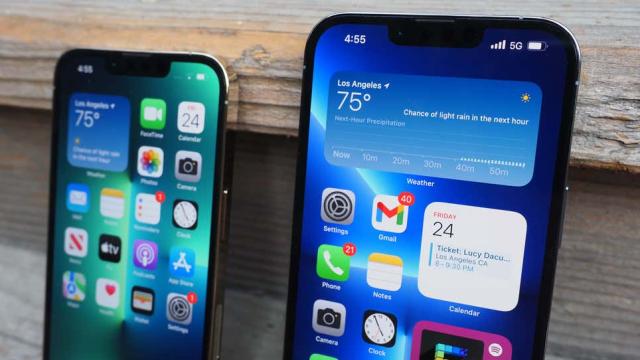Yes, the iPhone 13 recently underwent a minty green refresh, but now is not the time to buy Apple’s current smartphone if you’re hoping to get the best hardware. Apple’s developer conference is just around the corner, and more rumours about what’s on the horizon have sprouted up. If you can hold out another six months and can afford new gear, you’ll want to wait for the iPhone 14.
In addition to the M3 iMac, the rumour caldron is bubbling about the iPhone 14’s larger display size options, better cameras, and increased processing power on its Pro models. Bloomberg’s Mark Gurman, who is known for repeatedly being on the mark with Apple leaks and rumours, highlighted the iPhone 14 in the latest edition of his Power On newsletter, which is ripe with juicy information on what’s coming soon from all over Apple’s camp. Here’s what you might expect when Apple reveals the details of its next flagship.
The notch isn’t going anywhere
Whereas Google and Samsung’s models have adopted an every-other-year redesign cadence, Apple has switched to an every-three-years rhythm. Since the iPhone 14 is technically the third release since the iPhone 12, this is likely to be the last bump before a significant model makeover. The iPhone 14 will look like its predecessors, Gurman expects, down to the flat metal edges and the rounded corners that have become a staple of iPhone design.
The notch is also likely to make a comeback, says Bloomberg. That’s where you can expect to see Face ID and the front-facing camera. This is supposedly Apple’s solution until it can “fully embed Face ID and the front-facing camera into the display itself.” Bloomberg alleges that it’s still “three or four years away” from being able to do that, though I’m sure there are some Android manufacturers out there with ideas about how to get around that.
Bigger screens are en route
Apple started offering the iPhone Mini variant to folks who want smaller phones during the iPhone 12’s lifetime, but the iPhone 14 might have a different trajectory. Rather than start at a 5.4-inch iPhone Mini-variant and go up the roster in specs and price, Gurman speculates that Apple will offer a 6.1 and 6.7-inch iPhone in both Pro and standard configurations. That means you won’t have to spend the higher price for the Pro variant to get the larger screen.
Bloomberg notes that this bodes well as a strategic move from Apple as its shifts its business to better cater to its overseas customer base. In China, for instance, the Max is the highest-selling version of the iPhone, and keeping that screen size limited to a particular pricepoint hinders Apple’s growth potential within that key market. Overseas, it’s still a market share battle between Apple and Android.
Pro is so pro
From what sources told Gurman, Apple will attempt to differentiate its Pro model phones from its base phones more clearly in the future, in the same way that Google’s Pixel lineup offers a much more powerful Pro version and that Samsung packs it all into its Ultra variant phones. Choosing between the Pro and non-Pro models won’t just affect cameras or screen size, but will now likely come down to the other specs, too.
The iPhone 14 Pro is likely to have all the premium camera smarts that Apple offers, including a 48-megapixel sensor for the wide-angle camera, which would mean higher-resolution shots from the iPhone’s primary lens. The regular iPhone 14 will supposedly have only a 12-megapixel shooter. This sounds similar to the strategy of the latest Android phone releases, including Samsung’s Galaxy S22. In particular, the S22 Ultra offers a high-resolution primary camera, though it shoots photos by combining pixels to extract data.
The non-Pro version of the iPhone might also stay on the iPhone 13’s A15 chip, while the Pro version will get the increase to the new A16 processor. This sounds like a strategy to help with the supply chain issues that have flooded the industry. But it’s a wonder what the non-Pro versions of the iPhone 14 will offer that the iPhone 13 Pro doesn’t already, as that phone already has the A13 and this generation’s best specs. Why wouldn’t someone save money on last year’s iPhone 13 Pro and get the improved telephoto camera system instead of something that’s dialed down?
Who asked for satellite connectivity?
Lastly, Gurman writes that Apple is working on bringing satellite connectivity to the iPhone. This wouldn’t affect whether iPhones can make calls over satellite networks, but it would help report emergencies or send a short text to an emergency contact when out of range. Apple’s been working on bringing this to its lineup for a while.
Apple might also partner with Globalstar to serve as its satellite provider. The company agreed to buy 17 new satellites to offer “continuous satellite services” to an unnamed customer. Many are pegging that customer to be Apple. The feature sounds like what Apple does with the AirTags, wherein it creates a proprietary mesh network of sorts. At least with satellite offerings, Apple can spin it as a safety offering.
Most of these leaks and rumours are slowly spilling out in anticipation for Apple’s WWDC. The company’s developer conference will take place virtually the week of June 6-10. We’re likely to hear more about what’s new from the iPhone, Mac, iOS 16, watchOS 9, and macOS 13 then.
